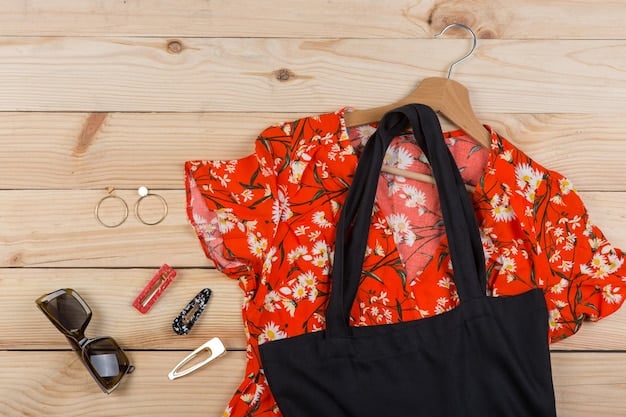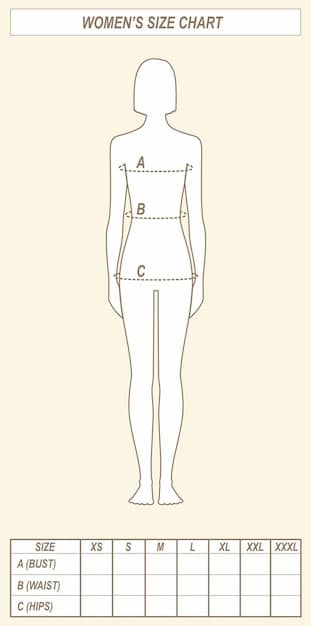Decoding Japanese Clothing Sizes: A US Shopper’s Guide

Decoding Japanese Clothing Sizes: A US Shopper’s Guide to Finding the Perfect Fit involves understanding key differences in sizing systems, materials, and styles, ensuring a satisfactory shopping experience whether purchasing online or in physical stores in Japan.
Navigating the world of international clothing sizes can be tricky, especially when venturing into the realm of Japanese fashion. This guide aims to simplify the process of decoding Japanese clothing sizes: a US shopper’s guide to finding the perfect fit, making your next purchase a breeze.
Understanding the Japanese Clothing Size System
The first step in successfully purchasing Japanese clothing is understanding their sizing system. Unlike the US system, which often uses inches or standard sizes (S, M, L), Japan utilizes a numerical system based on centimeters.
This difference can lead to confusion, but understanding the basics will help you convert Japanese sizes to their US equivalents.
Key Differences Between US and Japanese Sizes
The most significant difference lies in the measurements themselves. Japanese sizes tend to run smaller than their US counterparts. Factors such as body proportions and typical garment styles also influence size variations.
- Numerical vs. Letter Sizing: US often uses S, M, L, while Japan prefers numerical sizes.
- Body Proportions: Japanese clothing often fits slimmer body types better.
- Garment Styles: Traditional Japanese clothing sizing varies greatly from contemporary styles.
Understanding these foundational differences is essential for accurate conversions and a successful shopping experience. Always double-check size charts and read customer reviews to gauge the fit before making a purchase.
Converting Japanese Sizes to US Sizes: A Practical Guide
To accurately decode Japanese clothing sizes, it’s crucial to have a reliable conversion method. Here’s a practical guide to help you translate Japanese sizes to US equivalents for various clothing items.
Keep in mind that these conversions are approximate and can vary between brands, so check specific measurements whenever possible.

Converting Women’s Clothing Sizes
Women’s clothing sizes can be particularly confusing, but understanding the key measurements is essential. Start by measuring your bust, waist, and hips in inches. Then, reference the conversion charts below to find your corresponding Japanese size.
- Tops: US size 4 is roughly a Japanese size 9.
- Dresses: US size 6 often corresponds to a Japanese size 11.
- Bottoms: US size 26-inch waist is approximately a Japanese size 61 cm.
Converting Men’s Clothing Sizes
Men’s clothing sizes in Japan also tend to run smaller. When converting men’s sizes, focus on chest, waist, and inseam measurements. A good rule of thumb is to add 1-2 sizes to your US size when shopping for Japanese clothing.
- Shirts: A US size small may be a Japanese size medium or large.
- Pants: A US 32-inch waist is roughly a Japanese 82 cm.
- Jackets: A US size 40R translates to a Japanese size L or XL.
By focusing on exact measurements and referencing reliable conversion charts, US shoppers can confidently navigate Japanese clothing sizes. Always check the brand’s specific size chart for the most accurate fit.
Measuring Yourself Accurately for Japanese Clothing
Accurate self-measurement is a critical step in ensuring you purchase clothing that fits well, especially when decoding Japanese clothing sizes. Using a flexible tape measure, note down your key measurements.
Here’s how to ensure your measurements are precise for the best fit.
Essential Measurements to Take
Before consulting any size chart, you must have your accurate body measurements. Key measurements include:
- Bust/Chest: Measure around the fullest part of your bust or chest.
- Waist: Measure the narrowest part of your waistline.
- Hips: Measure around the fullest part of your hips.
- Inseam: Measure from the crotch down to the ankle along the inside of your leg.
Tips for Accurate Self-Measurement
Taking accurate body measurements doesn’t have to be difficult. To ensure you get the most precise readings, follow these helpful tips:
- Use a Flexible Tape Measure: Avoid using metal tape measures as they are not suitable for measuring body contours.
- Measure in Underwear: Wear only light undergarments for the most accurate measurements.
- Stand Naturally: Stand with your feet shoulder-width apart and breathe normally.
- Get Help: If possible, have a friend or family member assist you for more accurate readings, especially for back measurements.
Consistent diligence in taking accurate measurements not only bridges the gap between US and Japanese sizing systems but also boosts confidence in online and offline shopping decisions. Regular recalibration of these measurements will accommodate any bodily changes, reinforcing the shopper’s capacity to navigate the subtleties of global fashion sectors.
Navigating Online Japanese Clothing Retailers
Shopping at online Japanese clothing retailers can present unique challenges. While the convenience is unmatched, the risk of misinterpreting sizing information is higher.
Here are some strategies to effectively decode Japanese clothing sizes and avoid potential pitfalls when shopping online.

Understanding Size Charts on E-Commerce Sites
Most reputable Japanese online retailers offer detailed size charts, often in both centimeters and inches. Before making a purchase, painstakingly review these charts.
Compare these measurements against your own to ensure a better fit. Additionally, pay close attention to any size guides or notes provided by the retailer, as these can offer further clarification.
Reading Customer Reviews for Sizing Clues
Customer reviews are an invaluable resource when browsing online stores. Look for comments that specifically address sizing. Many reviewers will state whether the item runs small, large, or true to size.
Pay attention to reviewers who match your body type, as their experiences will likely be more relevant to you.
Dealing with Returns and Exchanges
Familiarize yourself with the retailer’s return and exchange policies. International shipping can be costly and time-consuming, so verifying the return process beforehand is vital.
Some retailers may offer free returns or exchanges, while others may require you to cover the shipping costs.
Shopping online for clothing from Japanese retailers can be a satisfying experience when you leverage the available resources. By understanding size charts, scrutinizing customer feedback, and managing return logistics, you greatly enhance your opportunities for sartorial triumph.
Tips for Shopping in Physical Stores in Japan
Shopping for clothing in physical stores in Japan offers a unique experience. However, it also requires some preparation to navigate the sizing and fit effectively.
Here are some tips to help you successfully decode Japanese clothing sizes while enjoying your in-store shopping spree.
Requesting Assistance from Store Staff
Don’t hesitate to ask for help from the store staff. Many Japanese retailers are known for their exceptional customer service. Staff members can provide size recommendations and clarification on specific measurements.
Trying on Clothes: Etiquette and Customs
When trying on clothes in Japan, be mindful of local etiquette. Here are some pointers:
- Use the Fitting Room: Always use the provided fitting rooms; do not try on clothes in the aisles.
- Keep Items Clean: Be careful not to stain or damage the clothing you try on.
- Remove Makeup: Use the provided face covers to avoid transferring makeup to clothing.
Understanding Common Japanese Fashion Terms
Familiarizing yourself with some common Japanese fashion terms can improve your shopping experience. Some key terms include:
- Furi-suku (フリスク): Free Size, often one-size-fits-all garments.
- Chibi (ちび): Small or petite sizing.
- Biggu saizu (ビッグサイズ): Plus sizes.
Shopping in physical Japanese stores offers unique cultural insights and personalized customer interaction. Understanding local etiquette, seeking staff support, and grasping essential vocabulary will significantly enhance your shopping adventures, increasing the potential for acquiring memorable and perfectly sized apparel.
Material Considerations When Buying Japanese Clothing
Beyond sizing, the materials used in Japanese clothing can also affect fit and comfort. Japanese clothing often features unique textiles and fabrics tailored to different seasons and styles.
Understanding these material characteristics will further aid in decoding Japanese clothing sizes and ensuring satisfaction with your purchase.
Common Fabrics Used in Japanese Clothing
Japanese clothing incorporates both traditional and contemporary fabrics. Some common materials include:
- Cotton (綿): A versatile and breathable fabric used in everyday wear.
- Linen (麻): Popular for summer clothing due to its lightweight and breathable properties.
- Silk (絹): Often used in formal wear, such as kimonos, for its luxurious feel.
How Fabrics Affect Fit
The nature of the fabric significantly impacts how a garment fits. For instance, stretchy materials like spandex offer more flexibility, while non-stretch fabrics require precise sizing.
Caring for Japanese Clothing Materials
Proper care is crucial for maintaining the quality and fit of your Japanese clothing. Always check the care label for specific instructions.
Understanding the types of fabrics and their unique characteristics can greatly enhance your shopping strategy, supporting better clothing selections suited to personal requirements. Paying attention to the fabric influences not just convenience but also durability, ensuring lasting enjoyment of Japanese fashion investments.
| Key Point | Brief Description |
|---|---|
| 📏 Size Conversion | Convert US sizes to Japanese by referring to detailed charts. |
| 🪡 Accurate Measurements | Measure bust, waist, hips. Stand naturally and get assistance if possible. |
| 🛍️ Online Shopping | Read customer reviews and check the retailer’s return policies. |
| 👘 In-Store Etiquette | Request assistance from store staff. Be mindful of local customs. |
Frequently Asked Questions (FAQ)
▼
Japanese sizes generally run smaller. A US size 4 might be a Japanese size 9. Always refer to specific size charts provided by the brand or retailer for the most accurate comparison.
▼
Use a flexible tape measure and measure your bust, waist, and hips. Stand naturally and ask someone to help for more accurate back measurements. Measure in light undergarments only.
▼
Yes, customer reviews are very useful. Look for reviews that specifically discuss sizing relative to US sizes and pay attention to reviewers who have similar body types to yours.
▼
Always use the fitting rooms provided. Be cautious not to stain or damage the clothing and consider using face covers to avoid makeup transfer. Ask for assistance if you need help with sizing.
▼
Familiarize yourself with terms like ‘Furi-suku’ (Free Size), ‘Chibi’ (Small/Petite), and ‘Biggu saizu’ (Plus Sizes). These terms can provide additional guidance during your shopping experience.
Conclusion
By understanding the nuances of Japanese sizing systems, taking accurate measurements, and considering material properties, US shoppers can confidently navigate both online and in-store shopping experiences in Japan. With the right preparation, finding the perfect fit is achievable, allowing you to enjoy the unique styles and high-quality craftsmanship of Japanese clothing.





